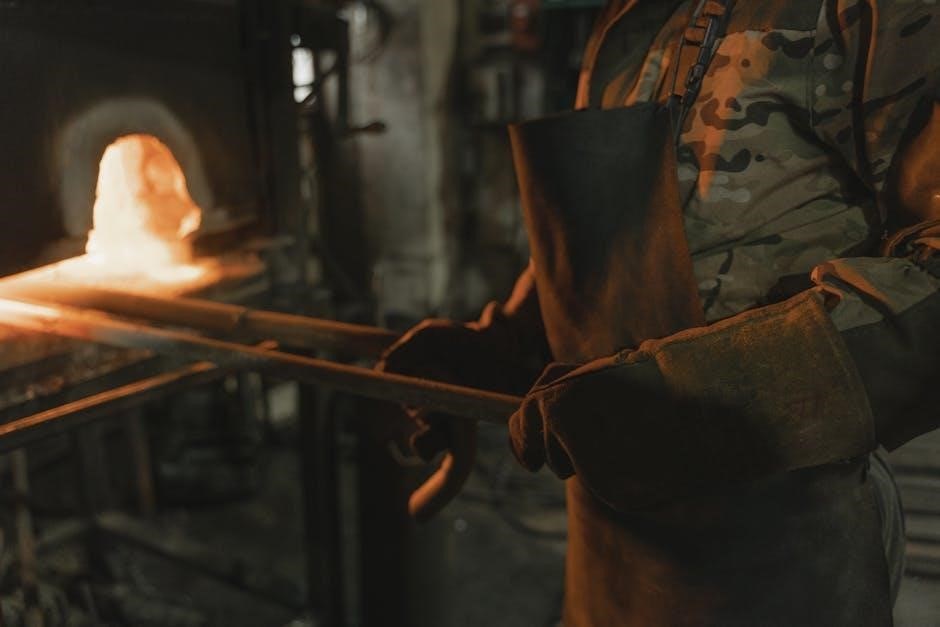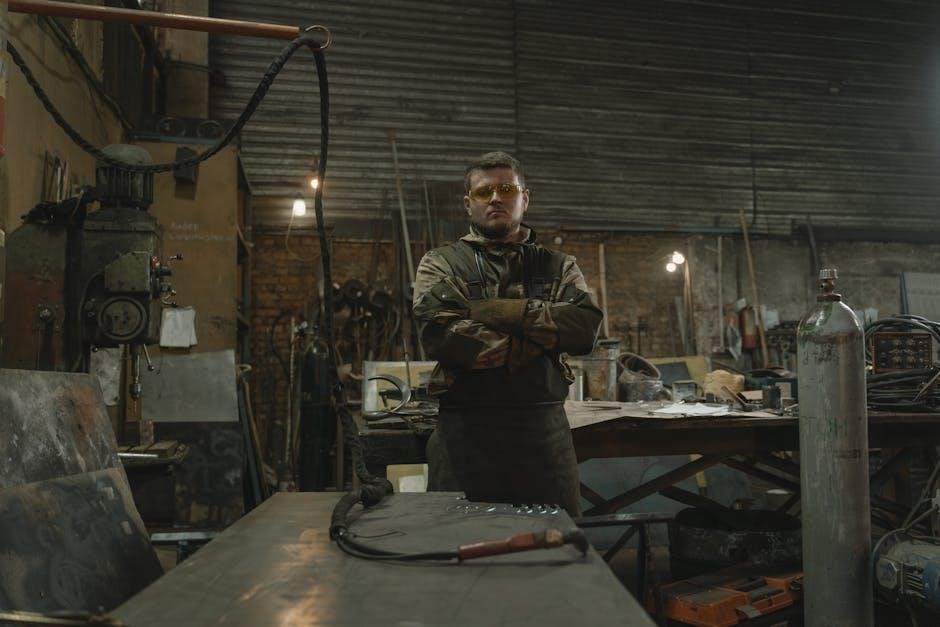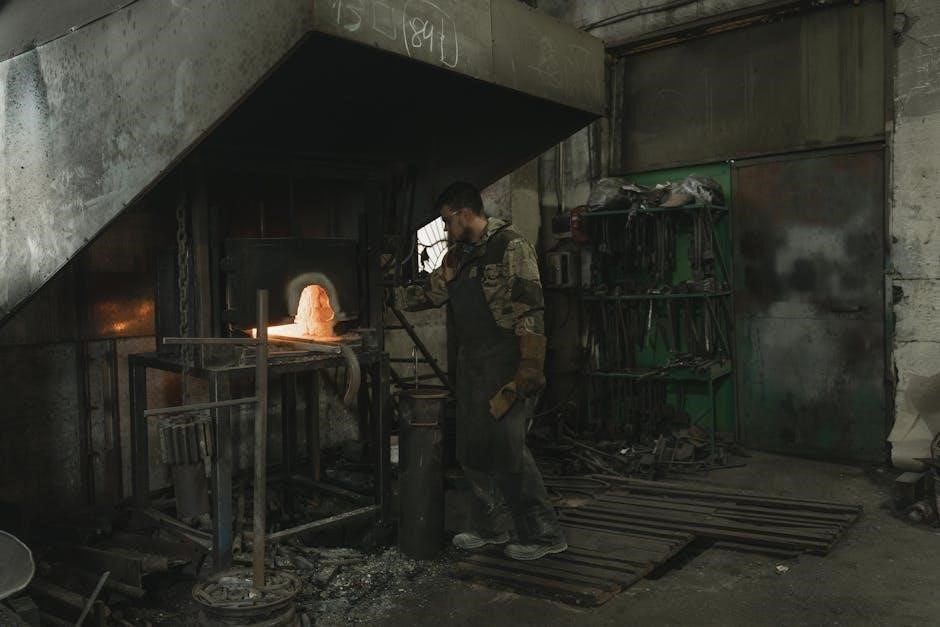
Smithy CB-1220 XL Manual: Overview
The Smithy CB-1220 XL manual serves as a vital resource for owners. It offers guidance on operation and maintenance. This document includes safety protocols, parts identification, and basic operational instructions. It is essential for efficient use.
The Smithy CB-1220 XL is a versatile 3-in-1 machine, combining lathe, mill, and drill functionalities into a single unit. This combination machine is designed to be a compact solution for various metalworking projects. It allows users to perform turning, milling, and drilling operations without the need for multiple separate machines, thus saving space and resources. The machine is favored by hobbyists and small shop owners due to its versatility and relatively small footprint. The CB-1220 XL features a sturdy build, designed to handle a range of materials. Understanding its capabilities through the operators manual is crucial. Proper maintenance and operation, as described in the manual, will ensure the machine’s longevity. The manual provides instructions for setup, safety, and basic operations. Accessing this information is key to maximizing the machine’s potential.

Manual Availability and Downloads
Finding the correct Smithy CB-1220 XL manual is important. Operators manuals, parts diagrams, and quick start guides are valuable. Online resources often provide downloadable PDFs. These resources ensure proper machine operation and maintenance.
Official Smithy Manuals (Operators, Parts, Quick Start)
Official Smithy manuals are essential for the safe and effective operation of the CB-1220 XL machine. These manuals, including the Operator’s Manual, Parts Diagram, and Quick Start Guide, provide comprehensive information about the machine’s features, functions, and maintenance procedures.
The Operator’s Manual offers detailed instructions on how to use the lathe, mill, and drill functions of the CB-1220 XL. It also includes safety precautions and troubleshooting tips. The Parts Diagram helps users identify and order replacement parts. It ensures that repairs are made with the correct components. The Quick Start Guide provides a brief overview of the machine’s basic operations, allowing new users to get started quickly.
These official manuals are invaluable resources for any CB-1220 XL owner, providing the knowledge and guidance needed to keep the machine running smoothly and safely. Accessing these resources often involves checking the Smithy website or contacting their customer service.
Third-Party Manuals and Resources
While official Smithy manuals are the primary source of information for the CB-1220 XL, third-party manuals and resources can offer supplementary insights. Online forums, machining communities, and independent websites often host user-generated guides, tips, and modifications. These resources can be particularly helpful for addressing specific issues or performing advanced techniques not covered in the official documentation.
However, it’s crucial to exercise caution when using third-party materials. Verify the accuracy and reliability of the information before implementing any suggestions. Some resources may be outdated or contain incorrect information. Always prioritize safety and consult the official Smithy manuals as the definitive reference. These alternative resources may cover topics like CNC conversion or custom modifications.
These resources can be a valuable supplement to the official documentation, offering diverse perspectives and practical solutions for CB-1220 XL owners. But always cross-reference with official manuals and prioritize safety.

Machine Operation and Setup
Proper machine operation and setup are crucial for achieving accurate results. Consult the manual for detailed instructions. Understand the lathe, mill, and drill functions. Always adhere to safety guidelines to prevent accidents.
Basic Operations: Lathe, Mill, Drill
The Smithy CB-1220 XL is a versatile machine capable of performing lathe, mill, and drill operations. Each operation requires specific setup and techniques detailed within the operator’s manual. For lathe operation, secure the workpiece properly in the chuck and select the appropriate cutting tool. Adjust speed and feed rates according to the material.
Milling involves using the vertical mill head to remove material. Ensure the workpiece is securely clamped to the table. Select the correct end mill and spindle speed. Drilling requires accurate positioning and controlled feed pressure. The manual provides detailed procedures for setting up and executing each operation safely and effectively.
Understanding the nuances of each function will maximize the machine’s capabilities and produce precision parts. Always consult diagrams. These will assist in understanding machine setup. Refer to troubleshooting tips to address operation problems.
Safety Precautions and Guidelines
Operating the Smithy CB-1220 XL safely requires strict adherence to safety precautions. Always wear appropriate eye protection to prevent debris from entering the eyes. Ensure all guards are in place before starting the machine. Never operate the machine under the influence of drugs or alcohol.
Keep the work area clean and free of clutter to prevent accidents. Securely clamp workpieces to prevent them from shifting during operation. Avoid wearing loose clothing or jewelry that could get caught in moving parts. Disconnect power before performing maintenance or adjustments. Familiarize yourself with emergency stop procedures. Never leave the machine unattended while it is running.
Regularly inspect the machine for worn or damaged parts and replace them immediately. Follow the manual’s guidelines for safe operation and maintenance. These will minimize the risk of injury. Prioritize safety to ensure a productive and accident-free working environment.

Parts and Maintenance
Proper parts maintenance is crucial for the CB-1220 XL. Regular inspections prevent issues. Identifying replacements quickly avoids downtime. Maintenance ensures smooth operation. Consult the manual for part numbers.
Identifying Replacement Parts
Accurately identifying replacement parts for your Smithy CB-1220 XL is essential for maintaining its optimal performance. The primary resource for this is the official parts diagram included in the operator’s manual. This diagram provides detailed visual representations of each component, along with corresponding part numbers. Referencing this diagram ensures you order the correct part, minimizing downtime and compatibility issues.
When using the parts diagram, pay close attention to the orientation and specific features of each component. Note any variations or revisions that may have occurred during the machine’s production run. If you are unsure about a particular part, cross-reference it with other available resources, such as online forums or technical support documentation.
For discontinued machines, identifying parts can be more challenging. However, the parts diagram remains a valuable starting point. Consider contacting specialized suppliers who may have access to obsolete or hard-to-find components. Always verify the specifications and dimensions of replacement parts before ordering to guarantee proper fit and function. Accurate identification prevents costly mistakes and ensures the longevity of your Smithy CB-1220 XL.
Discontinued Machine Support and Parts Availability
As the Smithy CB-1220 XL is a discontinued model, official support channels are limited. Direct technical assistance from Smithy may no longer be available. However, parts may still be accessible through various avenues. While the original manufacturer might not provide active support, several third-party suppliers specialize in parts for older machines. These suppliers often maintain inventories of obsolete components.
Online forums and communities dedicated to machining can also be valuable resources. Experienced users may offer advice, share knowledge about compatible parts, or even provide leads on where to find specific items. When sourcing parts from unofficial channels, exercise caution and verify the quality and compatibility of the components.
Consider exploring alternative solutions, such as fabricating custom parts or adapting components from other machines. Detailed measurements and specifications from the original parts manual are crucial for this approach. Although discontinued machine support presents challenges, resourceful troubleshooting and diligent searching can often yield viable solutions to keep your Smithy CB-1220 XL operational.

Troubleshooting and Common Issues
Addressing problems in your Smithy CB-1220 XL requires systematic troubleshooting. Common issues range from quill dropping to gear problems. The manual and online resources offer valuable insights for effective repairs.
Quill Dropping During Milling
Quill dropping during milling operations with the Smithy CB-1220 XL can be a frustrating and potentially damaging issue. This unintended descent of the quill can ruin workpieces and compromise accuracy. Several factors can contribute to this problem, requiring careful diagnosis and repair. One common cause is a worn or loose quill lock mechanism. This mechanism is designed to hold the quill securely in place during milling. Inspect the locking lever, screws, and internal components for wear, damage, or looseness. Adjust or replace parts as needed.
Another potential cause is excessive vibration during milling, particularly when using aggressive cutting parameters. Reduce vibration by using sharp cutting tools, reducing cutting speeds and feeds, and ensuring the workpiece is securely clamped. Examine the gib adjustments on the milling head, as loose gibs can also contribute to quill instability. Additionally, check the quill feed mechanism itself for any signs of binding or damage. Lubrication and cleaning may resolve some issues. If problems persist, consult the operator’s manual or a qualified technician.
Gear and Belt Issues
The Smithy CB-1220 XL, being a combination machine, relies on both gears and belts for power transmission. Issues with either system can significantly impact its performance. Gear problems often manifest as excessive noise, vibration, or complete failure to transmit power. Check the gear teeth for wear, damage, or broken teeth. Ensure proper lubrication and alignment. Belt issues commonly involve slippage, breakage, or excessive wear. Inspect belts for cracks, fraying, or glazing. Proper belt tension is critical for optimal performance; too loose and they slip, too tight and they wear quickly, potentially damaging pulleys.
Refer to the manual for correct belt tensioning procedures and gear lubrication recommendations. When replacing belts, use the specified type and size. Incorrect belts can lead to further problems. If gear issues persist, consider seeking advice from a qualified technician, as internal gear replacement can be complex. Understanding the gear and belt systems is vital for maintaining the machine’s reliability.